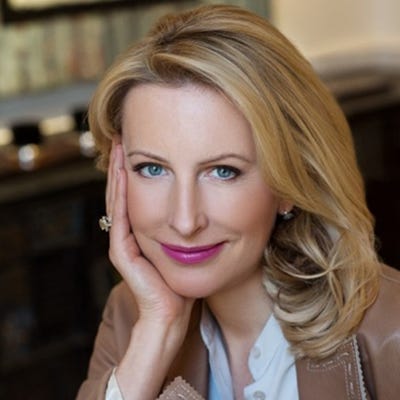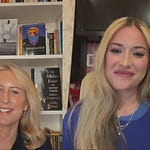Adam and I decided we’d each read “Nobody’s Girl” Virginia Giuffre’s searing memoir (co-authored with Amy Wallace) before we did yesterday’s live video chat, because we wanted to bring you a really thoughtful analysis of the book, and not simply riff off the headlines and excerpts already out there.
You can watch the video above to get our thoughts.
I think Adam’s main take-away is that, as he sees it, the memoir shows the arc of a “warrrior” (an adjective Giuffre writes that she loves) depicting Giuffre’s struggles as an abused, neglected child, and her growth into a woman who learned how to use the tools of the “system”, ie determined lawyers and civic-minded journalists to fight back, so that her chief abusers, Jeffrey Epstein and Ghislaine Maxwell, ultimately paid an appropriate price for what they’d done to her. So too, thanks largely to the ripple-effect of Giuffre’s lawsuits and constant media pressure, did Jean-Luc Brunel, who died in a prison in Paris before he could face trial; and Prince Andrew (just stripped of his title The Duke Of York). Others in Epstein’s orbit like his wealthy benefactors Les Wexner and Leon Black have, at the very least, paid a reputational price for their ill-judgement in financing him.
Other than Prince Andrew, Giuffre shies away from naming “names” of the men Epstein pimped her out to - but you can tell who they are, if you’ve read through the pages of Epstein and Maxwell discovery that’s out there, as we have, through her thinly-veiled pseudonyms. There’s the violent “Prime Minister’ - and “Billionaire One” and Billionaire Two” - as well as a host of shriveled, bald academics who can’t get an erection. Oh, and there’s also the guy who strokes Epstein, while Virginia, is trying to service him. I think many of us can take a good guess as to who that is. It also doesn’t take a great deal of imagination to figure out the identity of the married couple, expecting a child. Giuffre is sent by Epstein to massage each of them. She hopes the guy won’t be interested in more than a massage. She’s wrong.
Why doesn’t Giuffre name these predators in the book? Possibly because Knopf, her publishers were being cautious. But, also, she says, because she’s had enough. By the end she’s done with threats from people with bank balances to sink her. And who have the will and power to hurt her.
The book is remarkably unvarnished from start to finish in its depiction of the narrator as a flawed human being. She’d love to tell you that she’s never taken drugs; never groomed other girls for Epstein; and that she never resorted to painkillers towards the end of her life, after suffering chronic pain in her neck, and other parts of her body. But she did, and she tells us that she did.
One of the most compelling things about her narrative is how unafraid she is to explain the psychological complexity of her relationship with Epstein and Maxwell. Why she stayed - and she says she believes others did - for years. It’s something Epstein’s victims get asked repeatedly.
Giuffre says she stayed because, weird as it sounds, Epstein and Maxwell were on one level the family she had always longed for. There were times when she and Maxwell walked down a beach looking for sea glass and she saw Maxwell as the mother-figure she had never really had. And there were also times she thought of Epstein, who could spend hours talking to her about his love of science and physics - as well as how he thought the global age of consent should be when a girl starts menstruating - as a father-figure.
As for the sexual abuse she suffered at their hands? She was so conditioned to sexual abuse by the time she got there, having first been abused at the age of seven, that, with the exception of Epstein’s friend, the “Prime Minister,” a man who choked her to the point she thought she’d die, she knew how to compartmentalize, dividing her mind from her body, each time.
She also explains that her reasons for ultimately leaving Epstein and Maxwell’s household, when she went to Thailand to do a massage course, were not as straightforward as one might imagine. Yes, she wanted to escape the control and abuse. But she was also afraid of being replaced by the younger new “toy” in Epstein’s household, a girl named Nadia Marcinkova, who Giuffre taught to “massage’ Epstein, in the same way Maxwell had taught Giuffre, only two years previously. She was also afraid, that at 18, she was aging out; she was going to lose her status as Epstein’s “Number One” girl. And, to boot, Epstein and Maxwell wanted her to have their child, with the proviso she give up all rights to it.
It’s a complicated story, and she leans in to just how complicated. Carolyn Andriano, an Epstein victim who claimed in Maxwell’s criminal trial that she blamed Giuffre, not Maxwell for bringing her to Epstein’s house, is someone whose name Giuffre says she’s “ashamed to say” she cannot remember, but she does not doubt Andriano’s account. (Andriano died of an overdose in 2023). If you doubted the scale of Epstein’s sexual pyramid scheme: right there, is a chilling example of just how many girls went in and out of the door at Epstein’s home in El Brillo Way, in Palm Beach. So many, that even Giuffre can’t remember them all.
It’s a tragic irony, that as she starts clocking up legal wins against the powerful sexual predators, Giuffre’s body begins to fail her with a series of chronic injuries and pain. She sees it as karma: her body saying “this is the price you pay for all this.”
She shuts down physically, and then, mentally. She succumbs to the painkillers. She writes that she tries to commit suicide twice. You get the feeling that she knows the book is likely to outlive her - and that may be precisely why she has written it.
There’s a cost to telling your story of horrors to the media and to lawyers again and again and again, and Giuffre writes that she’s begun to think, she knows what it is. Her tank has run out of gas.
But before she left us in the spring of this year, she created another tank in Nobody’s Girl to keep her story alive, without her. Which is one more act of extraordinary courage in itself.
We all have many, many things to learn from this remarkable book.
And, fundamentally, Adam is right. It’s a story about a woman who became a warrior - and who won.
You can subscribe to Adam’s substack here.













